In today’s data-driven world, businesses need powerful tools to handle their ever-growing data needs. Enter SSIS 950, the latest evolution in SQL Server Integration Services. This cutting-edge platform is reshaping how we approach ETL processes, offering unparalleled efficiency and flexibility.
SSIS 950 is more than just an update. It’s a game-changer that’s revolutionizing data integration. Whether you’re a small business owner or part of a large corporation, SSIS 950 has the tools you need. It’s like having a Swiss Army knife for your data—variable, reliable, and always ready for action.
In this blog, we’ll explore every aspect of SSIS 950. We’ll uncover its key features, compare it to other tools, and show you how it can transform your data processes. Get ready to dive into the world of SSIS 950 and discover the future of streamlined data integration.
Understanding SSIS 950
It is a robust platform designed to simplify data movement and manipulation. It’s not just about moving data from point A to point B. SSIS 950 gives you the power to shape and mold your information to fit your exact needs.
Think of SSIS 950 as a magic wand for your data. It can instantly transform raw information into actionable insights. What sets SSIS apart is its enhanced ability to handle complex data integration scenarios. It’s like upgrading from a bicycle to a sports car—both get you from A to B, but one does it with much more style and efficiency.
Also, read this: Construction ERP Software News.ticbus.com
SSIS 950 vs. other data integration tools
When choosing a data integration tool, this tool stands out from the crowd. While other tools might excel in specific areas, This offers a comprehensive solution that covers all bases. It’s like comparing a Swiss Army knife to a single-purpose tool – one is more versatile.
It shines in scenarios where you need to handle diverse data sources, perform complex transformations, and integrate seamlessly with other Microsoft products. However, it’s always wise to consider your specific needs. If you’re deeply embedded in a non-Microsoft ecosystem or have very specialized requirements, you might find other tools more suitable.
Key Components of SSIS 950
SSIS 950 is built on three main pillars: Control Flow, Data Flow, and Event Handlers. These components work together like a well-oiled machine, each playing a crucial role in the data integration process.
Understanding these components is key to mastering SSIS 950 and unlocking its full potential. Let’s dive into each one:
Control Flow: The puppet master of your data
The Control Flow in SSIS 950 is all about orchestrating your data integration process. It’s where you define the sequence and logic of your package’s execution. Think of it as the brain of your SSIS package, making decisions and controlling the flow of operations.
With Control Flow, you can create complex workflows, implement conditional logic, and manage the overall execution of your ETL tasks. It’s like having a smart traffic system for your data, ensuring everything moves smoothly and efficiently.
Some key features of the Control Flow in SSIS 950 include:
1. Task sequencing: Define the order of execution for your tasks.
2. Conditional branching: Create if-then-else scenarios for your data flow.
3. Looping: Repeat tasks as needed based on specific conditions.
4. Parallel execution: Run multiple tasks simultaneously for improved performance.
Data Flow: Where the magic happens
Data Flow is the heart of SSIS 950, where data transformation takes center stage. This is where you define the journey your data takes from source to destination. You can extract data from various sources, apply a myriad of transformations, and load it into your chosen destinations.
It’s like a data assembly line, where raw information goes in one end and polished, usable data comes out the other. With a rich set of built-in transformations, you can perform complex data cleaning, aggregations, and calculations without writing a single line of code.
Key features of the Data Flow in SSIS 950 include
1. Source and destination adapters: Connect to a wide range of data sources and destinations.
2. Data transformations: Apply various operations to your data as it flows through the pipeline.
3. Data viewers: Monitor your data at any point in the flow for debugging and validation.
4. Error handling: Define how to handle data errors and exceptions during the flow.
Event Handlers: Your data’s bodyguards
Event Handlers in SSIS 950 are your secret weapon for creating robust and reliable packages. They allow you to define custom actions that trigger in response to specific events during package execution.
Whether it’s a package start, a task completion, or a package failure, Event Handlers have got you covered. They’re like having a team of vigilant guards watching over your data processes, ready to step in at a moment’s notice.
Read this blog: Tech the Hometrotters: Your Guide to Innovation and Home Improvement
Key features of Event Handlers in SSIS 950 include:
1. Custom error handling: Define specific actions for different types of errors.
2. Logging and auditing: Automatically record important events and package execution details.
3. Notifications: Set up alerts for critical events or package statuses.
4. Cleanup operations: Ensure resources are properly released, even if a package fails.
Benefits of SSIS 950
Is a powerful data integration tool that can transform how your organization handles data. It’s not just another piece of software—it’s a game-changer that can significantly boost your efficiency and improve your bottom line.
Here are some key benefits of SSIS 950
1. Powerful ETL Capabilities: It excels at extracting, transforming, and loading data, streamlining your data processes.
2. Handles Large Data Volumes: Whether you’re working with gigabytes or terabytes, it can handle it with ease.
3. Scalability: As your data needs grow, it grows with you, eliminating the need to switch tools as you expand.
4. Seamless SQL Server Integration: It works perfectly with SQL Server, providing easy access to database objects.
5. User-Friendly Interface: Its visual designer makes creating complex data flows a breeze, even for beginners.
6. Improved Data Quality: Built-in tools help clean and standardize your data, enhancing its overall quality.
7. Cost-Effective: As part of the SQL Server suite, it can be a cost-effective solution for organizations already using Microsoft products.
8. Automation Capabilities: Allows you to automate repetitive data tasks, saving time and reducing human error.
9. Robust Error Handling: With advanced error handling and logging features, it helps you quickly identify and resolve issues.
10. Flexibility: It can work with a wide variety of data sources and destinations, giving you the flexibility to integrate diverse systems.
Productivity on steroids
SSIS 950 is a productivity powerhouse designed to turn data novices into ETL ninjas. Its intuitive visual designer allows you to create complex data flows with drag-and-drop simplicity.
This means you can spend less time writing code and more time focusing on the logic and structure of your data processes. It’s like having a personal assistant that handles all the tedious parts of data integration, leaving you free to focus on the big picture.
Some productivity-enhancing features of SSIS 950 include
1. Reusable components: Create custom components that can be used across multiple packages.
2. Package templates: Start with pre-built templates for common integration scenarios.
3. Debugging tools: Easily identify and fix issues in your packages with built-in debugging features.
4. Performance tuning: Optimize your packages with built-in performance analysis tools.
Scalability that grows with you
One of SSIS 950’s standout features is its ability to handle big data without breaking a sweat. As your data needs grow, SSIS 950 grows with you. Its scalable data integration processes can handle everything from small, simple tasks to large, complex data warehousing operations.
This scalability means you won’t have to switch tools or platforms as your data volumes increase. Whether you’re running your packages on a single machine or distributing them across a cluster, it has the horsepower to keep up with your demands.
Key scalability features of SSIS 950 include
1. Parallel processing: Utilize multiple cores to speed up data processing.
2. Distributed execution: Run packages across multiple servers for improved performance.
3. In-memory processing: Leverage RAM for faster data operations on large datasets.
4. Incremental loading: Efficiently update your data warehouse by only processing changed data.
Common Use Cases for SSIS 950
It is just for one thing—it’s a flexible tool for many data integration tasks. From small companies to big businesses, organizations use this to solve various data problems. Here are some popular ways SSIS 950 is used.
Data warehousing is made easy.
Building data warehouses with this is like constructing a state-of-the-art data fortress. It provides all the tools you need to extract data from various sources, clean and transform it, and load it into your warehouse structure.
With this, you can automate your ETL processes, ensuring that your warehouse is always up-to-date with the latest data. This means you can spend less time managing your data and more time deriving insights from it.
Key features for data warehousing in SSIS 950 include
1. Slowly Changing Dimensions (SCD): Easily handle historical data changes in your dimensions.
2. Fact table loading: Efficiently load large fact tables with optimized bulk insert operations.
3. Data cleansing: Use built-in data quality services to ensure clean, consistent data in your warehouse.
4. Incremental loads: Update your warehouse with only the latest changes, saving time and resources.
Data migration without the migraine
Data migration can be a daunting task, but this turns it into a manageable process. Whether you’re consolidating databases, upgrading systems, or moving to the cloud, it provides the tools to make your migration smooth and error-free.
It’s like having a team of expert movers for your data. They know exactly how to pack, transport, and unpack your information without losing or damaging anything along the way.
SSIS 950 offers several features to simplify data migration
1. Schema mapping: Easily map source schemas to destination schemas, even when they differ.
2. Data type conversion: Automatically handle data type differences between source and destination.
3. Validation checks: Ensure data integrity during the migration process with built-in validation tools.
4. Rollback capabilities: Safely revert changes if something goes wrong during the migration.
The best structure regardless of SSIS 950
While it is a powerful tool, its effectiveness depends on how well you structure your projects. Creating a solid foundation for your SSIS projects is key to their long-term success and maintainability.
Here are some best practices for structuring your SSIS 950 projects
1. Use clear naming conventions: Adopt a consistent naming scheme for packages, tasks, and variables.
2. Organize packages logically: Group related packages into folders or projects for easy management.
3. Implement version control: Use source control systems to track changes and collaborate effectively.
4. Create reusable components: Design custom components that can be shared across multiple packages.
5. Document your work: Maintain clear documentation for your packages and overall project structure.
Establishment and Structure
Setting it up for success starts with creating a solid project structure. This involves more than just installing the software; it’s about establishing a framework that will support your data integration efforts for years to come.
A well-designed structure makes it easier to manage complex projects, collaborate with team members, and maintain your packages over time. Here are some key elements to consider.
1. Folder hierarchy: Create a logical folder structure for your SSIS projects and packages.
2. Environment-specific configurations: Set up separate configurations for development, testing, and production environments.
3. Security setup: Implement appropriate security measures to protect your data and packages.
4. Logging and monitoring: Establish a centralized logging system for easier troubleshooting and auditing.
Arranging ETL Cycles

Arranging your ETL cycles in SSIS 950 is an art form that combines technical skills with strategic thinking. It’s about creating a logical flow that efficiently moves and transforms your data while maintaining flexibility and scalability.
The key is to break down your ETL process into manageable steps, each handled by a separate SSIS task or component. Here’s a typical ETL cycle arrangement in it:
1. Data Extraction: Pull data from various sources using appropriate connection managers.
2. Data Staging: Load raw data into staging tables for initial processing.
3. Data Cleaning: Apply data quality rules and transformations to clean the staged data.
4. Data Transformation: Perform necessary calculations, aggregations, and business logic applications.
5. Data Loading: Load the transformed data into the target system (e.g., data warehouse).
6. Post-Load Processing: Update indexes and statistics and perform any necessary post-load operations.
Testing and Sending
Testing is a critical phase in any SSIS 950 project. It’s not just about ensuring your packages run without errors; it’s about consistently and efficiently producing the expected results.
A comprehensive testing strategy for SSIS 950 should include the following:
1. Unit testing: Test individual components and transformations in isolation.
2. Integration testing: Verify that different parts of your SSIS packages work correctly together.
3. Performance testing: Ensure your packages can handle expected data volumes within acceptable timeframes.
4. Error handling testing: Validate that your packages handle various error scenarios gracefully.
When it comes to deploying your SSIS 950 packages, a well-planned strategy is essential. This involves:
1. Choosing the right deployment model (project deployment vs. package deployment).
2. Managing environment-specific configurations.
3. Setting up appropriate security measures.
4. Implementing a version control system for your deployed packages.
Checking and Sponsorship
Ongoing monitoring and maintenance are crucial for the long-term success of your SSIS 950 projects. Regular checks help you identify and address performance issues, catch errors before they become critical, and ensure your packages continue to meet evolving business needs.
Here are some key aspects of SSIS 950 monitoring and maintenance
1. Performance monitoring: Regularly check package execution times and resource usage.
2. Error logging and alerting: Set up a system to notify you of package failures or performance issues.
3. Data quality checks: Implement ongoing data quality monitoring to ensure your data remains clean and consistent.
4. Package optimization: Periodically review and optimize your packages for better performance.
Conclusion
SSIS 950 stands as a powerhouse in data integration, offering a comprehensive solution for modern data challenges. Its robust ETL capabilities, scalability, and user-friendly interface make it an invaluable tool for organizations of all sizes. From building data warehouses to streamlining migrations, it provides the flexibility and power to handle complex data tasks efficiently.
Whether you’re a seasoned pro or just starting, mastering SSIS 950 can open new possibilities for your career and organization. By leveraging its powerful features and following best practices, you can unlock the full potential of your data and drive your business forward in today’s data-driven world.

BagisPack.com: Your ultimate travel companion. Explore expert travel tips, packing guides, and destination insights. Empowering adventurers with essential advice for seamless journeys around the globe.








